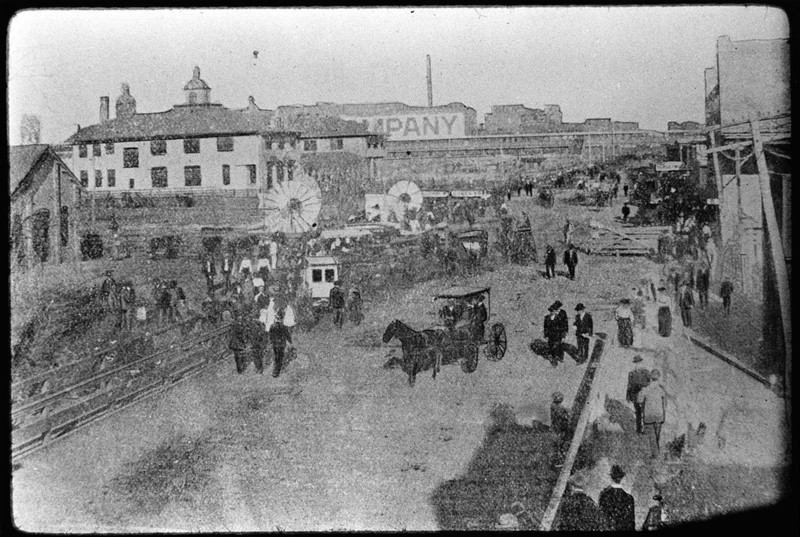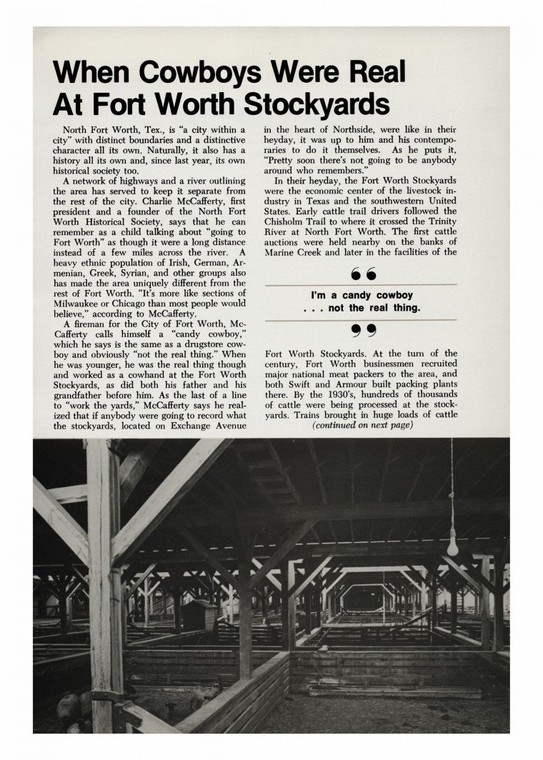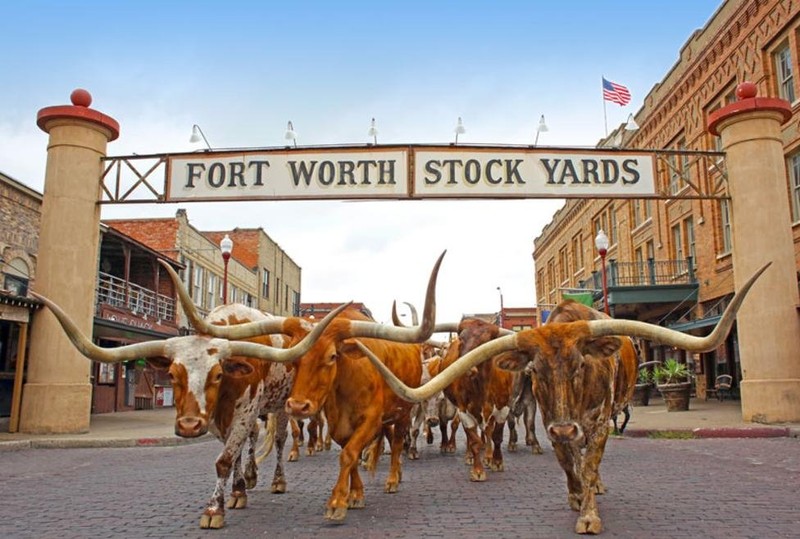Fort Worth Stockyards
Introduction
Text-to-speech Audio
The Fort Worth Stockyards was the biggest stockyard in Texas and was one of the biggest in the United States. The Fort Worth Stockyards played a crucial role in the expansion of Texas and the west. Millions of cattle, cattle drivers, and cattle owners came through the Fort Worth Stockyards through its time.
Images
"Early Street Activity in Fort Worth Stockyards Area" is from the Jack White photograph collection and is believed to be taken around 1900. 3

A picture of a Fort Worth newspaper shows what the cattle pens looked like in the stockyards. 6

A modern day photo showing cattle being driven through the Fort Worth Stockyards. 7

Backstory and Context
Text-to-speech Audio
Fort Worth originally was created by the United States Military in 1849 and served as an army post.1 The fort was part of the United States' military plan to have forts every 100 miles to protect the southern border. It was not until 1853 that the fort was vacated as troops were needed at the western border to help with western expansion.5
Before the United States abandoned the fort, a small community had grown near. With rich soil and protection from the army, many more citizens flocked to the area.2 In 1873, Fort Worth elected its first mayor and became an official city with a population of around 500 citizens.2 With Fort Worth being an official city and the railroad being built across Texas, Fort Worth wanted to acquire a railroad stop to help increase business.
In 1876 the railroad arrived to Fort Worth which brought tons of business and increased the population. With Fort Worth starting to boom in population and use for cattle the Fort Worth Stockyards opened in 1890 under the name of the Union Stockyards.4 Although business was booming the Fort Worth Stockyards were decades away from its peak. In 1893 a wealthy man from Boston named Greenleif Simpson was invited to visit the stockyards in attempt to acquire an investment from him. Luckily for the stockyards the cattle had more cattle in the pens than usual due to railroad strikes and inclement weather. Simpson bought the stockyard and renamed it the Fort Worth Stockyards.4
By the early 1900s the population of Fort Worth had quadrupled in size and the Fort Worth Stockyards were estimated to have had a million cattle sold per year.2
The Fort Worth Stockyards peaked in 1944 and unfortunately began to become obsolete. With newly waved roads and the growing trucking industry, the railroad industry began to decline and the Fort Worth Stockyards were not as necessary to transport cattle as it once was.4
What was once one of the biggest influences on the growth in Texas and expansion to the west, the Fort Worth Stockyards, today, bring in thousands of people for tourist attractions. The stockyard has since become a historical icon and monument to the past. Many people from all over the world travel to see the stockyards to get a taste of what the cattle driving life entailed. Even though cattle are not as prominent to the stockyards success as they once were, the stockyards still hold cattle auctions, rodeos, and host other events to bring in tourism and pay homage to its rich past.
Before the United States abandoned the fort, a small community had grown near. With rich soil and protection from the army, many more citizens flocked to the area.2 In 1873, Fort Worth elected its first mayor and became an official city with a population of around 500 citizens.2 With Fort Worth being an official city and the railroad being built across Texas, Fort Worth wanted to acquire a railroad stop to help increase business.
In 1876 the railroad arrived to Fort Worth which brought tons of business and increased the population. With Fort Worth starting to boom in population and use for cattle the Fort Worth Stockyards opened in 1890 under the name of the Union Stockyards.4 Although business was booming the Fort Worth Stockyards were decades away from its peak. In 1893 a wealthy man from Boston named Greenleif Simpson was invited to visit the stockyards in attempt to acquire an investment from him. Luckily for the stockyards the cattle had more cattle in the pens than usual due to railroad strikes and inclement weather. Simpson bought the stockyard and renamed it the Fort Worth Stockyards.4
By the early 1900s the population of Fort Worth had quadrupled in size and the Fort Worth Stockyards were estimated to have had a million cattle sold per year.2
“By the 1930’s, hundreds of thousands of cattle were being processed at the stockyards.” 6The Fort Worth Stockyards was in a great location for cattle auctions due to the fact that it was located on the Chisholm Trail and had the railroads.
The Fort Worth Stockyards peaked in 1944 and unfortunately began to become obsolete. With newly waved roads and the growing trucking industry, the railroad industry began to decline and the Fort Worth Stockyards were not as necessary to transport cattle as it once was.4
What was once one of the biggest influences on the growth in Texas and expansion to the west, the Fort Worth Stockyards, today, bring in thousands of people for tourist attractions. The stockyard has since become a historical icon and monument to the past. Many people from all over the world travel to see the stockyards to get a taste of what the cattle driving life entailed. Even though cattle are not as prominent to the stockyards success as they once were, the stockyards still hold cattle auctions, rodeos, and host other events to bring in tourism and pay homage to its rich past.
Sources
1 Myres, Sandra L. "Fort Worth, 1870-1900."
The Southwestern Historical Quarterly 72, no. 2 (1968): 200-22.
http://www.jstor.org/stable/30238014.
2 "Fort Worth History." City of Fort Worth, Texas. Accessed April 11, 2019. http://fortworthtexas.gov/about/history/.
3 "Early Street Activity in Fort Worth Stockyards Area, Ca. 1900." Univerity of Texas Libraries. May 30, 2018. Accessed March 08, 2019. https://library.uta.edu/digitalgallery-beta/img/10009503.
4 "History." Fort Worth Stockyards. August 09, 2016. Accessed April 12, 2019. https://www.fortworthstockyards.org/history.
5 Knight, Oliver, and Cissy Stewart. Lale. Fort Worth: Outpost on the Trinity. Fort Worth, TX: Texas Christian University Press, 1990.
6 "When Cowboys Were Real At Fort Worth Stockyards." History News 32, no. 8 (1977): 199-200. http://www.jstor.org/stable/42654640.
2 "Fort Worth History." City of Fort Worth, Texas. Accessed April 11, 2019. http://fortworthtexas.gov/about/history/.
3 "Early Street Activity in Fort Worth Stockyards Area, Ca. 1900." Univerity of Texas Libraries. May 30, 2018. Accessed March 08, 2019. https://library.uta.edu/digitalgallery-beta/img/10009503.
4 "History." Fort Worth Stockyards. August 09, 2016. Accessed April 12, 2019. https://www.fortworthstockyards.org/history.
5 Knight, Oliver, and Cissy Stewart. Lale. Fort Worth: Outpost on the Trinity. Fort Worth, TX: Texas Christian University Press, 1990.
6 "When Cowboys Were Real At Fort Worth Stockyards." History News 32, no. 8 (1977): 199-200. http://www.jstor.org/stable/42654640.
7 "Fort Worth Stockyards." Visit Irving Texas. Accessed April 12, 2019. https://www.irvingtexas.com/listings/fort-worth-stockyards/759/.
